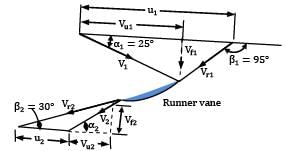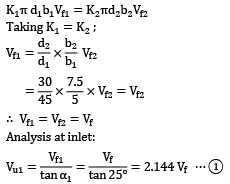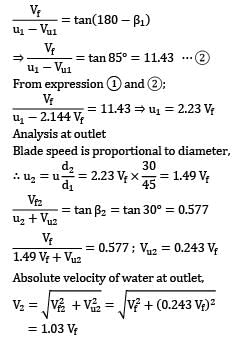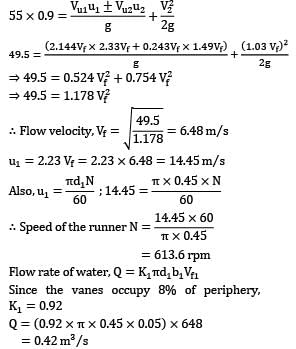Civil Engineering (CE) Exam > Civil Engineering (CE) Questions > The runner of an inward flow reaction turbin...
Start Learning for Free
The runner of an inward flow reaction turbine is of 45 cm diameter and 5 cm width at the outer periphery; the corresponding dimensions at the inner periphery are 30 cm and 7.5 cm respectively, and vanes occupy 8% of the periphery. The guide vane angle is 25° to the tangent to the runner and the moving vanes have an inlet angle of 95° (vanes inclined forward to the direction of motion) and an exit angle of 30°. Hydraulic and mechanical friction losses respectively amount to 10% and 5% of the supply head, and the pressure in the outer casing is 55 cm more than that at discharge from the runner. You are required to work out the speed of the runner for no shocks at entry and the power available at the turbine shaft.
Refer to Fig. for nomenclature and the vector diagrams.

- a)614 rpm and 86 kW
- b)656 rpm and 90 kW
- c)613 rpm and 90 kW
- d)500 rpm and 86 kw
Correct answer is option 'A'. Can you explain this answer?
Verified Answer
The runner of an inward flow reaction turbine is of 45 cm diameter an...
From continuity considerations, (area at inlet) × Vf1 = (area at outlet) × Vf2



View all questions of this test


From energy balance, Head supplied= work done or head utilized + energy at outlet (The head loss in the runner is being neglected)

Power developed by the turbine,

= 9810 × 0.42 × 0.524 × (6.48)2
= 90657 W
Since the mechanical losses amount to 5% Brake power = 90657 × 0.95 = 86124 W ≈ 86 kW
Most Upvoted Answer
The runner of an inward flow reaction turbine is of 45 cm diameter an...
From continuity considerations, (area at inlet) × Vf1 = (area at outlet) × Vf2





From energy balance, Head supplied= work done or head utilized + energy at outlet (The head loss in the runner is being neglected)

Power developed by the turbine,

= 9810 × 0.42 × 0.524 × (6.48)2
= 90657 W
Since the mechanical losses amount to 5% Brake power = 90657 × 0.95 = 86124 W ≈ 86 kW
Free Test
FREE
| Start Free Test |
Community Answer
The runner of an inward flow reaction turbine is of 45 cm diameter an...
From continuity considerations, (area at inlet) × Vf1 = (area at outlet) × Vf2





From energy balance, Head supplied= work done or head utilized + energy at outlet (The head loss in the runner is being neglected)

Power developed by the turbine,

= 9810 × 0.42 × 0.524 × (6.48)2
= 90657 W
Since the mechanical losses amount to 5% Brake power = 90657 × 0.95 = 86124 W ≈ 86 kW

|
Explore Courses for Civil Engineering (CE) exam
|

|
Similar Civil Engineering (CE) Doubts
Question Description
The runner of an inward flow reaction turbine is of 45 cm diameter and 5 cm width at the outer periphery; the corresponding dimensions at the inner periphery are 30 cm and 7.5 cm respectively, and vanes occupy 8% of the periphery. The guide vane angle is 25° to the tangent to the runner and the moving vanes have an inlet angle of 95° (vanes inclined forward to the direction of motion) and an exit angle of 30°. Hydraulic and mechanical friction losses respectively amount to 10% and 5% of the supply head, and the pressure in the outer casing is 55 cm more than that at discharge from the runner. You are required to work out the speed of the runner for no shocks at entry and the power available at the turbine shaft.Refer to Fig. for nomenclature and the vector diagrams.a) 614 rpm and 86 kWb) 656 rpm and 90 kWc) 613 rpm and 90 kWd) 500 rpm and 86 kwCorrect answer is option 'A'. Can you explain this answer? for Civil Engineering (CE) 2025 is part of Civil Engineering (CE) preparation. The Question and answers have been prepared according to the Civil Engineering (CE) exam syllabus. Information about The runner of an inward flow reaction turbine is of 45 cm diameter and 5 cm width at the outer periphery; the corresponding dimensions at the inner periphery are 30 cm and 7.5 cm respectively, and vanes occupy 8% of the periphery. The guide vane angle is 25° to the tangent to the runner and the moving vanes have an inlet angle of 95° (vanes inclined forward to the direction of motion) and an exit angle of 30°. Hydraulic and mechanical friction losses respectively amount to 10% and 5% of the supply head, and the pressure in the outer casing is 55 cm more than that at discharge from the runner. You are required to work out the speed of the runner for no shocks at entry and the power available at the turbine shaft.Refer to Fig. for nomenclature and the vector diagrams.a) 614 rpm and 86 kWb) 656 rpm and 90 kWc) 613 rpm and 90 kWd) 500 rpm and 86 kwCorrect answer is option 'A'. Can you explain this answer? covers all topics & solutions for Civil Engineering (CE) 2025 Exam. Find important definitions, questions, meanings, examples, exercises and tests below for The runner of an inward flow reaction turbine is of 45 cm diameter and 5 cm width at the outer periphery; the corresponding dimensions at the inner periphery are 30 cm and 7.5 cm respectively, and vanes occupy 8% of the periphery. The guide vane angle is 25° to the tangent to the runner and the moving vanes have an inlet angle of 95° (vanes inclined forward to the direction of motion) and an exit angle of 30°. Hydraulic and mechanical friction losses respectively amount to 10% and 5% of the supply head, and the pressure in the outer casing is 55 cm more than that at discharge from the runner. You are required to work out the speed of the runner for no shocks at entry and the power available at the turbine shaft.Refer to Fig. for nomenclature and the vector diagrams.a) 614 rpm and 86 kWb) 656 rpm and 90 kWc) 613 rpm and 90 kWd) 500 rpm and 86 kwCorrect answer is option 'A'. Can you explain this answer?.
The runner of an inward flow reaction turbine is of 45 cm diameter and 5 cm width at the outer periphery; the corresponding dimensions at the inner periphery are 30 cm and 7.5 cm respectively, and vanes occupy 8% of the periphery. The guide vane angle is 25° to the tangent to the runner and the moving vanes have an inlet angle of 95° (vanes inclined forward to the direction of motion) and an exit angle of 30°. Hydraulic and mechanical friction losses respectively amount to 10% and 5% of the supply head, and the pressure in the outer casing is 55 cm more than that at discharge from the runner. You are required to work out the speed of the runner for no shocks at entry and the power available at the turbine shaft.Refer to Fig. for nomenclature and the vector diagrams.a) 614 rpm and 86 kWb) 656 rpm and 90 kWc) 613 rpm and 90 kWd) 500 rpm and 86 kwCorrect answer is option 'A'. Can you explain this answer? for Civil Engineering (CE) 2025 is part of Civil Engineering (CE) preparation. The Question and answers have been prepared according to the Civil Engineering (CE) exam syllabus. Information about The runner of an inward flow reaction turbine is of 45 cm diameter and 5 cm width at the outer periphery; the corresponding dimensions at the inner periphery are 30 cm and 7.5 cm respectively, and vanes occupy 8% of the periphery. The guide vane angle is 25° to the tangent to the runner and the moving vanes have an inlet angle of 95° (vanes inclined forward to the direction of motion) and an exit angle of 30°. Hydraulic and mechanical friction losses respectively amount to 10% and 5% of the supply head, and the pressure in the outer casing is 55 cm more than that at discharge from the runner. You are required to work out the speed of the runner for no shocks at entry and the power available at the turbine shaft.Refer to Fig. for nomenclature and the vector diagrams.a) 614 rpm and 86 kWb) 656 rpm and 90 kWc) 613 rpm and 90 kWd) 500 rpm and 86 kwCorrect answer is option 'A'. Can you explain this answer? covers all topics & solutions for Civil Engineering (CE) 2025 Exam. Find important definitions, questions, meanings, examples, exercises and tests below for The runner of an inward flow reaction turbine is of 45 cm diameter and 5 cm width at the outer periphery; the corresponding dimensions at the inner periphery are 30 cm and 7.5 cm respectively, and vanes occupy 8% of the periphery. The guide vane angle is 25° to the tangent to the runner and the moving vanes have an inlet angle of 95° (vanes inclined forward to the direction of motion) and an exit angle of 30°. Hydraulic and mechanical friction losses respectively amount to 10% and 5% of the supply head, and the pressure in the outer casing is 55 cm more than that at discharge from the runner. You are required to work out the speed of the runner for no shocks at entry and the power available at the turbine shaft.Refer to Fig. for nomenclature and the vector diagrams.a) 614 rpm and 86 kWb) 656 rpm and 90 kWc) 613 rpm and 90 kWd) 500 rpm and 86 kwCorrect answer is option 'A'. Can you explain this answer?.
Solutions for The runner of an inward flow reaction turbine is of 45 cm diameter and 5 cm width at the outer periphery; the corresponding dimensions at the inner periphery are 30 cm and 7.5 cm respectively, and vanes occupy 8% of the periphery. The guide vane angle is 25° to the tangent to the runner and the moving vanes have an inlet angle of 95° (vanes inclined forward to the direction of motion) and an exit angle of 30°. Hydraulic and mechanical friction losses respectively amount to 10% and 5% of the supply head, and the pressure in the outer casing is 55 cm more than that at discharge from the runner. You are required to work out the speed of the runner for no shocks at entry and the power available at the turbine shaft.Refer to Fig. for nomenclature and the vector diagrams.a) 614 rpm and 86 kWb) 656 rpm and 90 kWc) 613 rpm and 90 kWd) 500 rpm and 86 kwCorrect answer is option 'A'. Can you explain this answer? in English & in Hindi are available as part of our courses for Civil Engineering (CE).
Download more important topics, notes, lectures and mock test series for Civil Engineering (CE) Exam by signing up for free.
Here you can find the meaning of The runner of an inward flow reaction turbine is of 45 cm diameter and 5 cm width at the outer periphery; the corresponding dimensions at the inner periphery are 30 cm and 7.5 cm respectively, and vanes occupy 8% of the periphery. The guide vane angle is 25° to the tangent to the runner and the moving vanes have an inlet angle of 95° (vanes inclined forward to the direction of motion) and an exit angle of 30°. Hydraulic and mechanical friction losses respectively amount to 10% and 5% of the supply head, and the pressure in the outer casing is 55 cm more than that at discharge from the runner. You are required to work out the speed of the runner for no shocks at entry and the power available at the turbine shaft.Refer to Fig. for nomenclature and the vector diagrams.a) 614 rpm and 86 kWb) 656 rpm and 90 kWc) 613 rpm and 90 kWd) 500 rpm and 86 kwCorrect answer is option 'A'. Can you explain this answer? defined & explained in the simplest way possible. Besides giving the explanation of
The runner of an inward flow reaction turbine is of 45 cm diameter and 5 cm width at the outer periphery; the corresponding dimensions at the inner periphery are 30 cm and 7.5 cm respectively, and vanes occupy 8% of the periphery. The guide vane angle is 25° to the tangent to the runner and the moving vanes have an inlet angle of 95° (vanes inclined forward to the direction of motion) and an exit angle of 30°. Hydraulic and mechanical friction losses respectively amount to 10% and 5% of the supply head, and the pressure in the outer casing is 55 cm more than that at discharge from the runner. You are required to work out the speed of the runner for no shocks at entry and the power available at the turbine shaft.Refer to Fig. for nomenclature and the vector diagrams.a) 614 rpm and 86 kWb) 656 rpm and 90 kWc) 613 rpm and 90 kWd) 500 rpm and 86 kwCorrect answer is option 'A'. Can you explain this answer?, a detailed solution for The runner of an inward flow reaction turbine is of 45 cm diameter and 5 cm width at the outer periphery; the corresponding dimensions at the inner periphery are 30 cm and 7.5 cm respectively, and vanes occupy 8% of the periphery. The guide vane angle is 25° to the tangent to the runner and the moving vanes have an inlet angle of 95° (vanes inclined forward to the direction of motion) and an exit angle of 30°. Hydraulic and mechanical friction losses respectively amount to 10% and 5% of the supply head, and the pressure in the outer casing is 55 cm more than that at discharge from the runner. You are required to work out the speed of the runner for no shocks at entry and the power available at the turbine shaft.Refer to Fig. for nomenclature and the vector diagrams.a) 614 rpm and 86 kWb) 656 rpm and 90 kWc) 613 rpm and 90 kWd) 500 rpm and 86 kwCorrect answer is option 'A'. Can you explain this answer? has been provided alongside types of The runner of an inward flow reaction turbine is of 45 cm diameter and 5 cm width at the outer periphery; the corresponding dimensions at the inner periphery are 30 cm and 7.5 cm respectively, and vanes occupy 8% of the periphery. The guide vane angle is 25° to the tangent to the runner and the moving vanes have an inlet angle of 95° (vanes inclined forward to the direction of motion) and an exit angle of 30°. Hydraulic and mechanical friction losses respectively amount to 10% and 5% of the supply head, and the pressure in the outer casing is 55 cm more than that at discharge from the runner. You are required to work out the speed of the runner for no shocks at entry and the power available at the turbine shaft.Refer to Fig. for nomenclature and the vector diagrams.a) 614 rpm and 86 kWb) 656 rpm and 90 kWc) 613 rpm and 90 kWd) 500 rpm and 86 kwCorrect answer is option 'A'. Can you explain this answer? theory, EduRev gives you an
ample number of questions to practice The runner of an inward flow reaction turbine is of 45 cm diameter and 5 cm width at the outer periphery; the corresponding dimensions at the inner periphery are 30 cm and 7.5 cm respectively, and vanes occupy 8% of the periphery. The guide vane angle is 25° to the tangent to the runner and the moving vanes have an inlet angle of 95° (vanes inclined forward to the direction of motion) and an exit angle of 30°. Hydraulic and mechanical friction losses respectively amount to 10% and 5% of the supply head, and the pressure in the outer casing is 55 cm more than that at discharge from the runner. You are required to work out the speed of the runner for no shocks at entry and the power available at the turbine shaft.Refer to Fig. for nomenclature and the vector diagrams.a) 614 rpm and 86 kWb) 656 rpm and 90 kWc) 613 rpm and 90 kWd) 500 rpm and 86 kwCorrect answer is option 'A'. Can you explain this answer? tests, examples and also practice Civil Engineering (CE) tests.

|
Explore Courses for Civil Engineering (CE) exam
|

|
Signup to solve all Doubts
Signup to see your scores go up within 7 days! Learn & Practice with 1000+ FREE Notes, Videos & Tests.



























